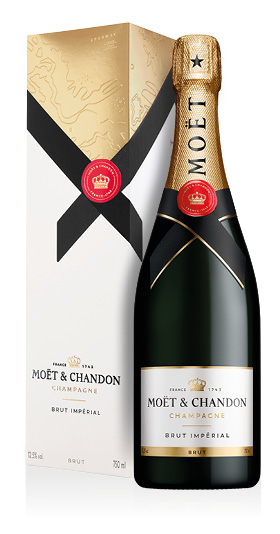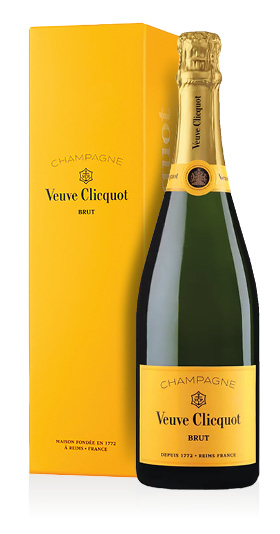Champagne AOC Cuvée Réservée Brut Léon Launois
0,75 ℓ
90
Aperitifs, Fish, White meat
Discount 30%
21.30 €
per bottle
(0,75 ℓ)
28.40 €/ℓ
incl. VAT and taxes
Was: 30.50 €
Lowest price: 30.50 €
Free shipping
Champagne AOC Brut Grande Réserve Mademy
0,75 ℓ
Aperitifs
Quantity discount 30%
27.90 €
per bottle
(0,75 ℓ)
37.20 €/ℓ
incl. VAT and taxes
Regular price: 39.90 €
Free shipping
Champagne AOC Brut Tradition Collection Classique Sophie Bouchet
0,75 ℓ
Fish, Starters, Risotto
Discount 25%
22.90 €
per bottle
(0,75 ℓ)
30.53 €/ℓ
incl. VAT and taxes
Champagne Brut AOC Impérial Moët & Chandon
0,75 ℓ, Gift box
91
90
Oysters, Sushi, Aperitifs, Fruit
Discount 11%
37.90 €
per bottle
(0,75 ℓ)
50.53 €/ℓ
incl. VAT and taxes
Was: 42.90 €
Lowest price: 42.90 €
Free shipping
Champagne Grand Cru Brut AOC Tradition Laurier
0,75 ℓ
93
Aperitifs, Fish
Quantity discount 25%
37.40 €
per bottle
(0,75 ℓ)
49.87 €/ℓ
incl. VAT and taxes
Regular price: 49.90 €
Free shipping
Champagne AOC Brut Baron de Marck
0,75 ℓ
France, Champagne
Aperitifs, Fish, Starters
Sale
22.80 €
per bottle
(0,75 ℓ)
30.40 €/ℓ
incl. VAT and taxes
Was: 25.70 €
Lowest price: 22.70 €
Champagne AOC Grand Cru Brut Réserve Blanc de Blancs Saintgybryen
0,75 ℓ
France, Champagne
Fish, Aperitifs
Sale
28.80 €
per bottle
(0,75 ℓ)
38.40 €/ℓ
incl. VAT and taxes
Was: 45 €
Lowest price: 27 €
Champagne AOC Spécial Réserve Léonce d'Albe
0,75 ℓ
95
93
Molluscs, Starters, Fish
Sale
24 €
per bottle
(0,75 ℓ)
32 €/ℓ
incl. VAT and taxes
Was: 29.90 €
Lowest price: 23.90 €
Champagne AOC Brut Réserve Emile Leclère
0,75 ℓ
Aperitifs, Fish
Quantity discount 5%
34.70 €
per bottle
(0,75 ℓ)
46.27 €/ℓ
incl. VAT and taxes
Regular price: 36.50 €
Free shipping
Champagne AOC Cuvée Réservée Rosé Brut Léon Launois
0,75 ℓ
France, Champagne
Aperitifs, White meat, Fish
Sale
26.90 €
per bottle
(0,75 ℓ)
35.87 €/ℓ
incl. VAT and taxes
Was: 34.50 €
Lowest price: 26.90 €
Free shipping
Champagne Brut Premier Cru AOC Fernand Lemaire
0,75 ℓ
Aperitifs
Quantity discount 5%
33.20 €
per bottle
(0,75 ℓ)
44.27 €/ℓ
incl. VAT and taxes
Regular price: 34.90 €
Free shipping
Champagne Brut AOC Yellow Label Veuve Clicquot
0,75 ℓ, Gift box
91
90
Seafood, Aperitifs, Fish
45.90 €
per bottle
(0,75 ℓ)
61.20 €/ℓ
incl. VAT and taxes
Free shipping
Champagne Brut AOC R de Ruinart
0,75 ℓ
93
90
Fish, Seafood, Aperitifs, Sushi
54 €
per bottle
(0,75 ℓ)
72 €/ℓ
incl. VAT and taxes
Free shipping
Champagne Brut AOC Grande Réserve Charles Ellner
0,75 ℓ
91
92
Aperitifs, Fish
Sale
28.90 €
per bottle
(0,75 ℓ)
38.53 €/ℓ
incl. VAT and taxes
Was: 39.90 €
Lowest price: 25.90 €
Free shipping
Champagne Grand Cru Ambonnay Brut Rosé AOC Secondé Simon Laurier
0,75 ℓ
94
Red meat, Fish
Quantity discount 25%
41.20 €
per bottle
(0,75 ℓ)
54.93 €/ℓ
incl. VAT and taxes
Regular price: 54.90 €
Free shipping
Champagne Extra Brut AOC Première Cuvée Bruno Paillard
0,75 ℓ
92
91
Molluscs, Starters, Fried food, Aperitifs, Caviar
49 €
per bottle
(0,75 ℓ)
65.33 €/ℓ
incl. VAT and taxes
Free shipping
Champagne AOC Blanc de Noirs Léonce d'Albe
0,75 ℓ
92
Game birds, Aperitifs, Risotto
Sale
26.30 €
per bottle
(0,75 ℓ)
35.07 €/ℓ
incl. VAT and taxes
Was: 34.90 €
Lowest price: 26.30 €
Champagne AOC Brut de Brut Collection Classique Sophie Bouchet
0,75 ℓ
France, Champagne
Starters, Grilled white meat, Fish
Discount 22%
25.80 €
per bottle
(0,75 ℓ)
34.40 €/ℓ
incl. VAT and taxes
{Snippet: CHAMPAGNE}


















